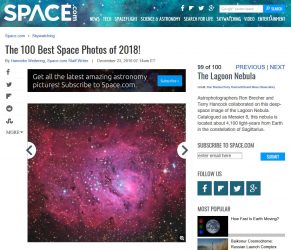M8, the Lagoon Nebula
Click image for full size version
December 17, 2018
 This image shows the Lagoon Nebula, catalogued as Messier 8 (M8). It lies in the Milky Way in Sagittarius, at a distance of about 4,100 light years. This emission nebula is glowing mainly due to excited atoms of hydrogen. The hydrogen atoms absorb energy from the hot, bright stars in the central region of the nebula, and then emit the energy as red light. Dark dust punctuates the nebula throughout. It measures about 55×20 light years. There is a ton of interesting stuff all around this field, some of which can be seen in one of my early deep-sky images, from 2009.
This image shows the Lagoon Nebula, catalogued as Messier 8 (M8). It lies in the Milky Way in Sagittarius, at a distance of about 4,100 light years. This emission nebula is glowing mainly due to excited atoms of hydrogen. The hydrogen atoms absorb energy from the hot, bright stars in the central region of the nebula, and then emit the energy as red light. Dark dust punctuates the nebula throughout. It measures about 55×20 light years. There is a ton of interesting stuff all around this field, some of which can be seen in one of my early deep-sky images, from 2009.
The data for the image was generously provided by my good friend Terry Hancock.
Tekkies:
Sky-Watcher Esprit 150 f/7 refractor, debayered QHY 168C camera, Optolong L, R, G and B filters, Paramount ME. Acquisition with MaximDL 6. Focused with FocusMax 3. All pre-processing and processing in PixInsight. Acquired from Grand Mesa Observatory, September 9-15, 2018.
13x5m L, 11x5m R, 10x5m G and 11x5m B, unbinned frames (total=3hr45m).
Image scale for this camera/telescope combination is 0.92″/pixel.
Data Reduction and Cleanup
The BatchPreProcessing script was used to perform calibration, cosmetic correction and registration of all frames. ImageIntegration was used to make the L, R, G and B masters. DynamicCrop was used to crop all the masters identically. DynamicBackgroundExtraction was applied to each master.
Synthetic Luminance
Creation and cleanup of SynthL: The L, R, G and B masters were combined using ImageIntegration (average, additive with scaling, noise evaluation, iterative K-sigma / biweight midvariance, no pixel rejection).
Deconvolution: A star mask was made to use as a Local Deringing Support Image. A copy of the image was stretched to use as a range mask. Deconvolution was applied (50 iterations, regularized Richardson-Lucy, external PSF made using the PSFImage script).
Linear Noise Reduction: MultiscaleLinearTransform was used to reduce noise in the SynthL image. An internal mask was used, with layer settings for threshold and strength as follows:Layer 1: 3, 0.7 Layer 2: 2, 0.5 Layer 3: 2, 0.45.
Stretching: HistogramTransformation was applied to the SynthL to make a pleasing, bright image.
RGB Creation
Creation and cleanup: ChannelCombination was used to make color image from the R, G and B masters. The RGB image was processed with PhotometricColorCalibration using a small preview of background sky as the background reference.
Linear Noise Reduction: MultiscaleLinearTransform was used to reduce noise in the RGB image. An internal mask was used with amplitude 180, and layer settings for threshold and strength as follows: Layer 1: 3, 0.75 Layer 2: 2, 0.6 Layer 3: 2, 0.5.
Stretching: MaskedStretch, followed by HistogramTransformation, was applied to the RGB image to make a pleasing, bright image. Use of MaskedStretch prevented core burnout of bright stars.
Combining SynthL with RGB
The processed SynthL was applied to the RGB image using LRGBCombine.
Additional Processing
Nonlinear Noise Reduction: TGVDenoise was used in L*a*b* mode to reduce noise in the background and dim parts of the nebula. A mask was used to protect high-signal areas.
Sharpening: MultiscaleLinearTransform was used to sharpen Layers 2 and 3 (strengths of 0.2 and 0.2 respectively. A mask was used to protect dim nebulosity, background and stars.
Contrast Enhancement: LocalHistogramEqualization was applied with a scale of 50 (max contrast 2, strength 0.52, 1 iteration), followed by a scale of 150 (max contrast 1.5, strength 0.48, 1 iteration).
Final Steps: Star sizes were reduced using MorphologicalTransformation’s Morphological Selection tool with a blurred star mask that selected large and medium sized stars (circular structure with size 5×5 pixels, selection 0.14, strength 0.3, 3 iterations). ExponentialTransformation was applied to boost faint nebulosity (PIP, strength =1, smoothness = 0, lightness mask checked). Background, nebula and star brightness, contrast and saturation were adjusted in several iterations using Curves with masks as required. The DarkStructureEnhance script was applied with 8 layers and a strength of 0.20.






Beautifully done!!!
Thanks!